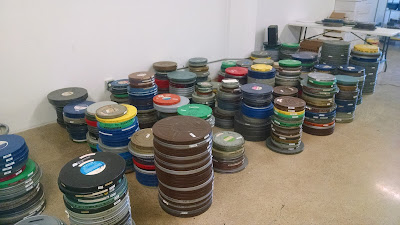Rediscovering Chicago's Film History
Last year I became the LIBRAS Archives Special Interest
Group Chairperson; part of my job is to put events together which interest
archivists and librarians within the LIBRAS community. The most
recent event
was a visit and tour of the Chicago Film Archives. Their website states: “The
Chicago Film Archives is a non-profit 501(c) (3) institution established in
late 2003 in order to preserve and catalogue over five thousand 16mm films
donated by the Chicago Public Library.”
 |
| Extra copies of films donated by the Chicago Public Library |
During the visit, we discussed how the film industry in
Chicago boomed during the early 20th century with actors including
Charlie Chaplin getting their first start at Essanay Studios. Chicago was the
film industry hub until the production companies moved to Hollywood.
The films
at CFA cover the “dark ages” of Chicago and Midwest filmmaking. As a regional archive
their collections relate to Midwest history, amateur filmmakers, and home
movies from donors. They also hold the film collection donated from the Chicago
Public Library, which includes educational and travel films, silent films,
foreign and American-made theatrical films, documentaries, industrials,
newsreels, sports events and children's films.
 |
| CFA staff with Kinetta Archival Film Scanner, taken from CFA's Twitter |
One of the films shown to us was The Fairy Princess from amateur filmmaker Margaret Conneely. WATCH IT HERE. From the CFA website: “[Conneely] frames stop-motion animation and
trick photography with live action footage to fuel her very own Christmas fairy
tale.” We then compared it to a Christmas home movie from the Stacy Maugans Collection, 1965-1984. Even though the films are from the same era with similar subject matter, the Conneely film was purpose built and told a story,
while the Maugan’s home movie captures real life for this family.
The 3 person staff also performs conservation work to
restore or recreate a film's original look and sound. They recently purchased a
Kinetta Archival Film Scanner, which captures 4K resolution images for
digitization purposes. It helps them create access copies of films which are
shown at local and international film screenings. In terms of preservation, films
that are no longer stable for physical handling can be run through the Kinetta
to create a beautiful reproduction.
 |
| Work station to check physical conditions of films |
Amidst all that, we discussed how CFA compares to colleges
or historical institutions, particularly in light of service functions,
approaches to access, funding, and collection content. The main differences we
found were funding and associations with other institutions. CFA relies on
grants, donations, and a business model of charging for goods and services. It
is also not affiliated with a college, university, or historical society,
making the mission of CFA very specific.
I encourage everyone to check out their website and watch
some of the 1600 films available online.
I’d also like to the Nancy, Amy, and
Brian for a fantastic experience!


Comments
Post a Comment